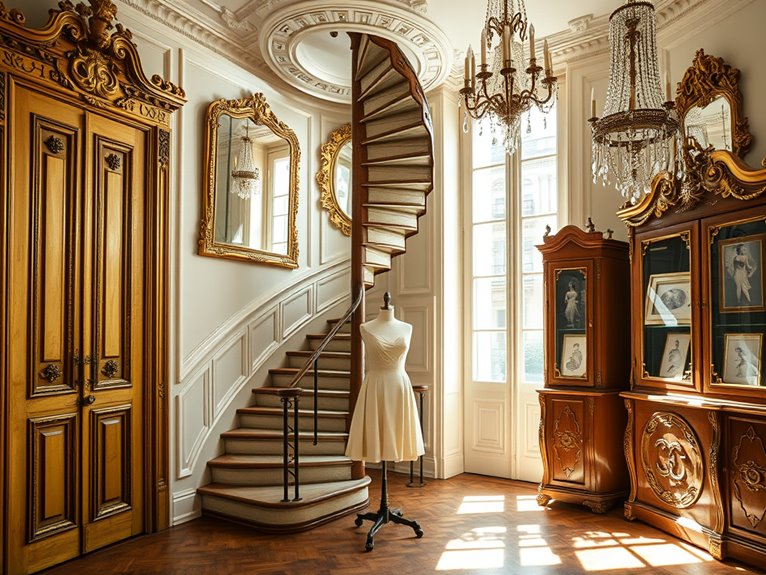
7 Historic Fashion Houses in Paris Offering Tours
Paris's most iconic fashion houses welcome visitors for exclusive peeks behind their elegant curtains! You can tour Coco Chanel's mirrored apartment, explore Louis Vuitton's original workshop in Asnières, admire YSL's preserved studio, discover Dior's historic flagship, visit the Hermès museum, browse Balenciaga's archive collection, and marvel at Boucheron's heritage room. Most require advance bookings and have strict visitor limits – but the incredible craftsmanship and historic details you'll discover make the planning worthwhile.
Inside Coco Chanel's Apartment at 31 Rue Cambon
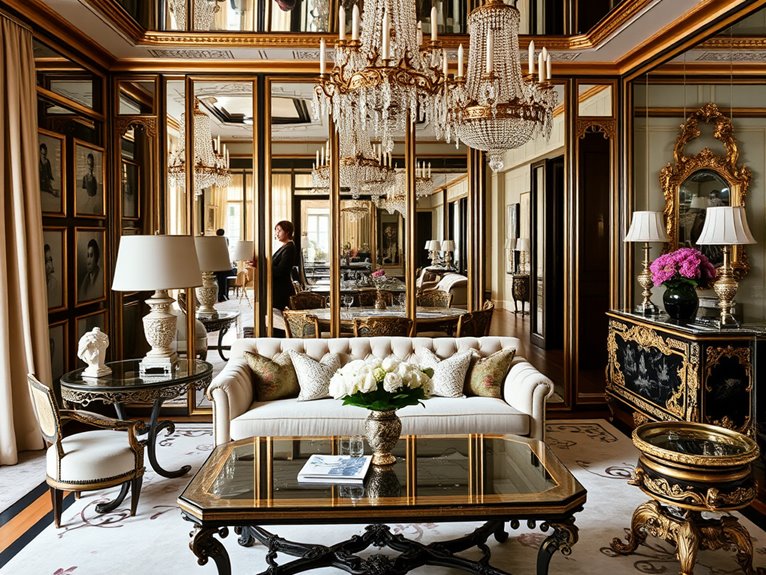
Perched above the iconic Chanel boutique in Paris, Coco Chanel's private apartment at 31 Rue Cambon stands as a perfectly preserved time capsule of the legendary designer's personal style and creative sanctuary. This second-floor space, where Mademoiselle Chanel never actually slept but spent countless hours entertaining and finding inspiration, remains exactly as she left it, offering visitors a rare glimpse into the intimate world of fashion's most influential figure.
The apartment's decor reflects the same principles that revolutionized fashion: elegant simplicity paired with dramatic touches, Chinese coromandel screens alongside crystal chandeliers, and the recurring motifs that would become house signatures. Every corner tells a story, from the iconic mirrored staircase where Chanel would secretly observe her fashion shows below, to the crystal-laden suede couch where she would recline while making vital business decisions.
Quick Facts:
- Visiting Hours: By appointment only, Monday-Friday
- Cost: Not open to general public; access through special arrangement
- Photography: Limited photography permitted, no flash
- Group Size: Small groups only (typically 4-6 people)
- Duration: Approximately 45-60 minutes
- Language: Tours available in French and English
- Dress Code: Smart casual required
The Mirrored Staircase
The legendary Art Deco staircase, lined with mirrors at precise angles, served as Coco's strategic viewing point during fashion shows. While the staircase begins at the boutique's ground floor, its most significant portion leads to the apartment. The mirrors were positioned so Chanel could observe reactions to her collections without being seen, offering her unprecedented insight into her clients' authentic responses.
The Grand Salon
The apartment's main room showcases Chanel's aesthetic in its purest form. Dominated by a massive beige suede couch, rock crystal chandeliers, and her beloved Coromandel screens, this space hosted fashion's elite. The room features the recurring number 5, lions, camellias, and interlocked Cs in various forms – elements that would become synonymous with the house of Chanel.
Pro Tips:
Book well in advance through luxury travel specialists or high-end concierge services, as regular tours are not available to the general public. The best viewing experience occurs during morning hours when natural light streams through the windows, illuminating the apartment's intricate details and allowing for better appreciation of the space's original colors and textures. Consider combining your visit with an appointment at the boutique below to experience the full spectrum of Chanel's legacy.
Practical Advice:
While photography restrictions are strict, focus on absorbing the details that inspired Chanel's designs – the wheat sheaf tables (symbolizing prosperity), the crystal chandeliers, and the Chinese screens. Keep notes or sketches of elements that interest you, as these details appear throughout Chanel's collections past and present. Remember that while the apartment is not a museum, it demands the same respect and care, as many original furnishings and personal items remain in place.
The Louis Vuitton Family Home and Workshop in Asnières
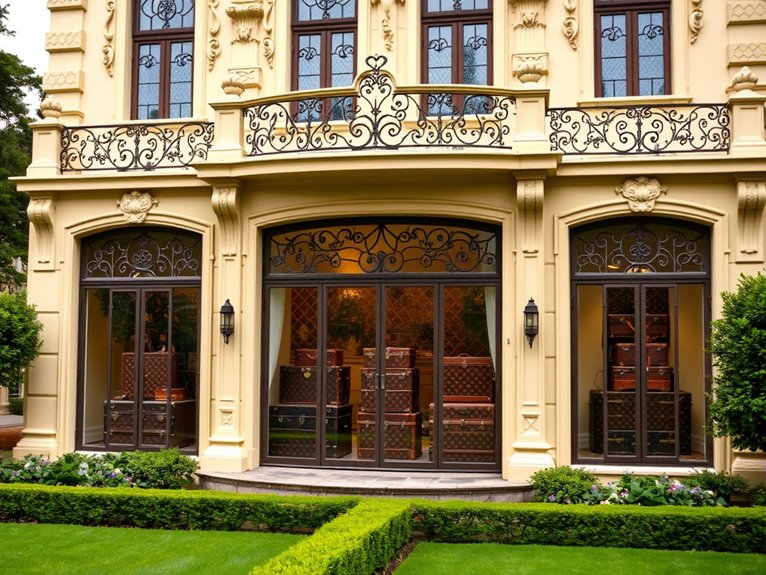
Located in the Parisian suburb of Asnières-sur-Seine, the Louis Vuitton family home and workshop stands as a living representation of the legendary fashion house's heritage. This historic site, established in 1859, continues to serve as both a working atelier and a private museum, offering visitors a rare glimpse into the brand's craftsmanship legacy and family history.
The property combines the original family residence, a masterpiece of art nouveau architecture, with the adjacent workshop where Louis Vuitton's most prestigious pieces are still handcrafted today. This unique destination showcases the intersection of luxury craftsmanship, family tradition, and innovative design that has defined the brand for over 160 years.
Quick Facts:
- Visiting Hours: By appointment only, typically Tuesday-Saturday, 10 AM-5 PM
- Tour Duration: Approximately 90 minutes
- Cost: Complimentary but requires advance reservation
- Photography: Limited to specific areas; no flash photography
- Group Size: Maximum 12 people per tour
- Language: Tours available in French and English
- Accessibility: Wheelchair accessible
- Dress Code: Smart casual required
The Family Residence
The art nouveau mansion, designed by Jules Cheret in 1878, features stunning period architecture and original furnishings. The residence showcases the family's private collection of travel items, photographs, and personal effects. The highlight is the winter garden, with its remarkable glass ceiling designed by Louis Majorelle. Insider tip: Request to see the original order books from the 1800s, which are occasionally displayed.
The Workshop
The atelier remains a working facility where Louis Vuitton's most exclusive pieces and special orders are crafted. Visitors can observe artisans creating custom trunks and leather goods using traditional techniques. The workshop maintains the same layout and many of the same tools used since its establishment. Unique feature: Look for the original wooden trunk molds dating back to the 19th century, still used for special commissions.
The Heritage Room
This dedicated space houses an rotating exhibition of historic Louis Vuitton pieces, including innovation milestones and significant custom orders for notable clients. The collection includes the first stackable flat trunk and early examples of the iconic monogram canvas. Lesser-known fact: The room contains Georges Vuitton's personal collection of locks and mechanisms used to develop the company's patented security systems.
Pro Tips:
Schedule visits for weekday mornings when craftspeople are most active in the workshop. Request a tour during the changing of exhibitions to potentially glimpse additional pieces from the archives being transported or arranged. Consider combining your visit with the nearby Foundation Louis Vuitton museum for a thorough brand experience.
Practical Advice:
Reservations must be made at least three months in advance through Louis Vuitton's client services. Be prepared to provide identification matching your reservation details. Photography permissions vary depending on ongoing production work, so confirm current policies when booking. The location is accessible via RER Line A to Asnières-sur-Seine station, followed by a short walk. For the most exclusive experience, request a tour that coincides with the craftspeople's lunch break, when they sometimes engage with visitors and answer questions about their work.
The Yves Saint Laurent Museum and Heritage Gallery
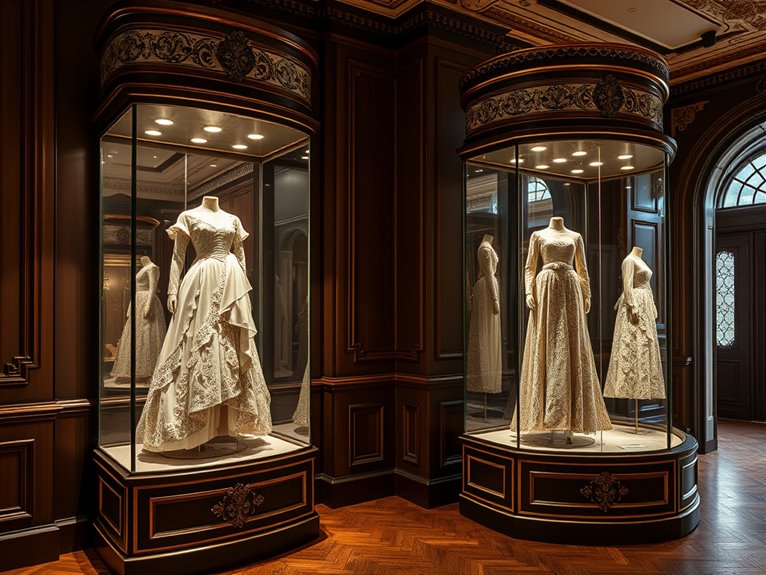
The Yves Saint Laurent Museum, housed in the historic Hôtel Particulier at 5 Avenue Marceau, stands as a reflection of one of fashion's most influential designers. This intimate museum occupies the former haute couture house where Yves Saint Laurent worked for nearly 30 years, creating revolutionary designs that transformed women's fashion. The preserved workspace, including the studio where he designed his collections, offers visitors an unprecedented glimpse into the creative process of a fashion genius.
The museum's carefully curated exhibitions rotate bi-annually, showcasing not only Saint Laurent's iconic designs but also his artistic inspirations, sketches, and the meticulous craftsmanship behind his creations. The Heritage Gallery provides an extensive look at the designer's legacy, from his groundbreaking "Le Smoking" tuxedo suit to his Mondrian-inspired dresses, demonstrating how he revolutionized twentieth-century fashion.
Quick Facts:
- Opening Hours: Tuesday-Sunday, 11:00-18:00 (closed Mondays)
- Admission: €10 adults, €7 reduced rate
- Photography: Not permitted in most areas
- Best visiting times: Weekday mornings
- Languages: Audio guides available in 8 languages
- Accessibility: Wheelchair accessible
- Duration: Average visit takes 1-1.5 hours
Main Exhibition Space:
The main museum space spans multiple floors, featuring rotating exhibitions that highlight different aspects of Saint Laurent's work. The preservation of original furniture, fabric samples, and tools creates an authentic atmosphere that transports visitors back to the golden age of haute couture. Insider tip: Book a guided tour in advance for access to additional areas normally closed to the public.
The Studio:
Saint Laurent's preserved studio remains exactly as he left it, complete with his desk, fabric swatches, and personal items. This intimate space offers unprecedented insight into his creative process and working methods. The natural light flooding through large windows illuminates the room just as it did when the designer worked there. Insider tip: Visit during late afternoon when the lighting is particularly dramatic.
Heritage Gallery:
The permanent collection showcases over 5,000 haute couture garments and 15,000 accessories, though only a carefully selected portion is displayed at any time. The collection includes iconic pieces from various periods of Saint Laurent's career, accompanied by detailed information about their historical and cultural significance. Insider tip: Ask about the special temporary exhibits that often feature never-before-seen pieces from the archives.
Pro Tips:
To fully appreciate the museum's offerings, visit on weekday mornings when crowds are thinner and the lighting is ideal for viewing the detailed craftsmanship of the garments. Consider purchasing tickets online in advance, especially during peak tourist seasons or special exhibitions. The museum shop offers exclusive books and merchandise not available elsewhere, making it worth setting aside time for shopping at the end of your visit.
Practical Advice:
When planning your visit, allow enough time to explore the surrounding Golden Triangle fashion district. The museum is located near other important fashion landmarks and luxury boutiques, making it easy to combine with a broader fashion-focused itinerary. While photography is restricted, detailed catalogs and books available in the museum shop provide excellent documentation of the collections. Consider booking a combination ticket that includes access to both the museum and temporary exhibitions for the most thorough experience.
Dior's Historic Flagship at 30 Avenue Montaigne
The iconic address of 30 Avenue Montaigne stands as more than just a boutique – it represents the beating heart of Christian Dior's legacy and the birthplace of the "New Look" that revolutionized post-war fashion. This legendary maison, which first opened its doors in 1946, has recently undergone an extensive two-year renovation, emerging as a stunning 10,000-square-meter temple to haute couture, fashion history, and French luxury.
The flagship location combines retail space, a museum, restaurant, and private shopping suites into an immersive experience that tells the story of one of fashion's most influential houses. Visitors can explore everything from historic couture pieces to contemporary collections, while experiencing the meticulous craftsmanship and attention to detail that defines the House of Dior.
Quick Facts:
- Opening Hours: 10:00 AM – 7:30 PM (Monday-Saturday)
- Average Price Point: Luxury range (Ready-to-wear starting at €2,000)
- Reservation Required: For restaurant and private shopping experiences
- Photography: Permitted in most areas except certain exhibition spaces
- Languages: Multi-lingual staff available
- Accessibility: Fully wheelchair accessible
- Payment Methods: All major credit cards, mobile payments
The La Galerie Dior Museum
This newly created museum space showcases the evolution of the fashion house through carefully curated exhibitions featuring historic garments, accessories, and personal items belonging to Christian Dior. The rotating displays guarantee fresh experiences with each visit, while the permanent collection highlights iconic pieces that defined fashion history.
Le Restaurant Monsieur Dior
The elegant in-house restaurant offers classic French cuisine with a contemporary twist, serving lunch and afternoon tea in a setting that reflects the aesthetic codes of the house. Advance reservations are essential, particularly for the coveted afternoon tea service. Insider tip: Request a table near the winter garden for the most atmospheric dining experience.
The Haute Couture Salons
These private spaces maintain the original spirit of Dior's couture presentations while incorporating modern luxury amenities. Though primarily reserved for haute couture clients, guided tours are occasionally available by special arrangement. The original curved staircase, where models once descended during fashion shows, remains a focal point.
Pro Tips:
The best time to visit is during weekday mornings, particularly Tuesday or Wednesday, when the boutique is less crowded. For the fullest experience, book a guided tour in advance through the Dior concierge service. Photography enthusiasts should visit during golden hour when natural light streams through the building's restored windows, creating magical effects on the iconic Toile de Jouy wallcoverings.
Practical Advice:
While the boutique welcomes walk-in visitors, making advance arrangements through the concierge service can enhance the experience notably. This is especially important for the restaurant, private shopping experiences, or guided tours. Dress code is smart casual at minimum, and more formal attire is recommended for dining or private shopping appointments. The boutique's central location in the 8th arrondissement makes it easily accessible via metro (Alma-Marceau station) or taxi, though parking can be challenging during peak hours.
The Hermès Private Museum and Workshop
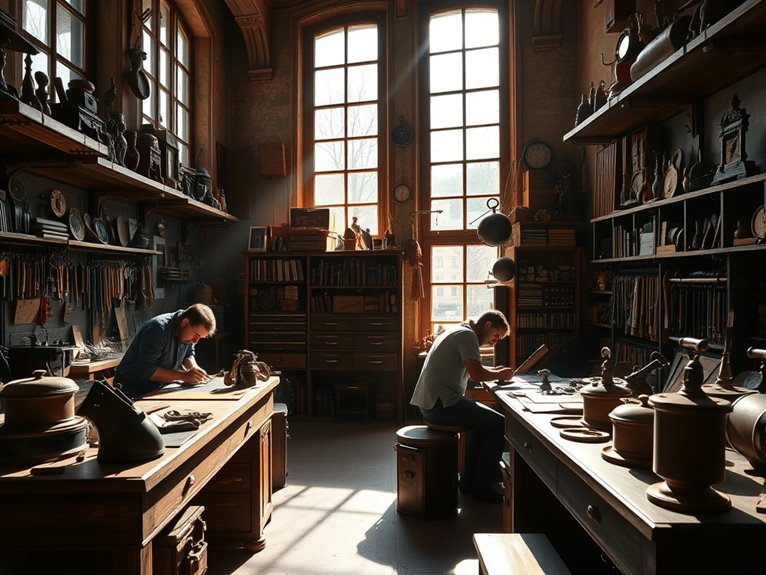
The Hermès Private Museum and Workshop stands as a reflection of one of fashion's most prestigious maisons, offering visitors a rare glimpse into the artisanal heritage of this legendary brand. Situated in the historic heart of Paris, this carefully curated space showcases the evolution of Hermès from its humble beginnings as a harness workshop in 1837 to its current status as a global luxury powerhouse.
Visitors to this exclusive venue experience firsthand the meticulous craftsmanship that defines Hermès, from its iconic silk scarves to its coveted leather goods. The museum houses an extensive collection of historic pieces, while the workshop provides an intimate look at contemporary artisans practicing time-honored techniques that have been passed down through generations.
Quick Facts:
- Opening Hours: Monday-Friday, 10:00 AM – 6:00 PM (by appointment only)
- Average Visit Duration: 1.5-2 hours
- Cost: Complimentary for approved visitors
- Photography: Limited to specific areas; no flash photography
- Language Options: Guided tours available in French, English, and Japanese
- Location: 24 Rue du Faubourg Saint-Honoré, 75008 Paris
- Accessibility: Wheelchair accessible
- Booking Requirements: Minimum 3 months advance reservation
Museum Collection Highlights:
The museum's collection spans over 180 years of Hermès history, featuring rare pieces such as custom-made travel trunks, vintage riding equipment, and limited-edition handbags. The carefully preserved artifacts include the first Kelly bag ever created and original silk scarf designs from the 1930s. Insider tip: Request to see the secret archive room, which houses prototype designs rarely shown to the public.
Workshop Experience:
Visitors can observe master craftsmen at work, creating signature Hermès pieces using traditional techniques. Each artisan specializes in specific skills, from leather cutting to hand-stitching, and typically spends 15-20 hours creating a single bag. Unique feature: The workshop maintains the original tools used by Thierry Hermès, still employed for special commissions.
Heritage Documentation Center:
The documentation center houses thousands of original designs, patterns, and order books dating back to the company's founding. Researchers and fashion historians can access this valuable resource by special arrangement. Lesser-known fact: The center contains personal correspondence between the Hermès family and notable clients, including European royalty.
Pro Tips:
Morning visits offer the best opportunity to observe artisans at work, as many complex procedures begin early in the day. Schedule your visit during fashion week off-seasons (typically February-March and September-October) for more intimate tours and increased chances of seeing special demonstrations.
Practical Advice:
While securing a visit requires patience and persistence, working through your country's Hermès boutique can improve your chances of approval. Dress code is business casual, and visitors should be prepared to store large bags and coats. Photography permissions must be obtained in advance, and some areas remain strictly off-limits to cameras due to proprietary techniques and designs.
Balenciaga's Couture House and Archive Collection
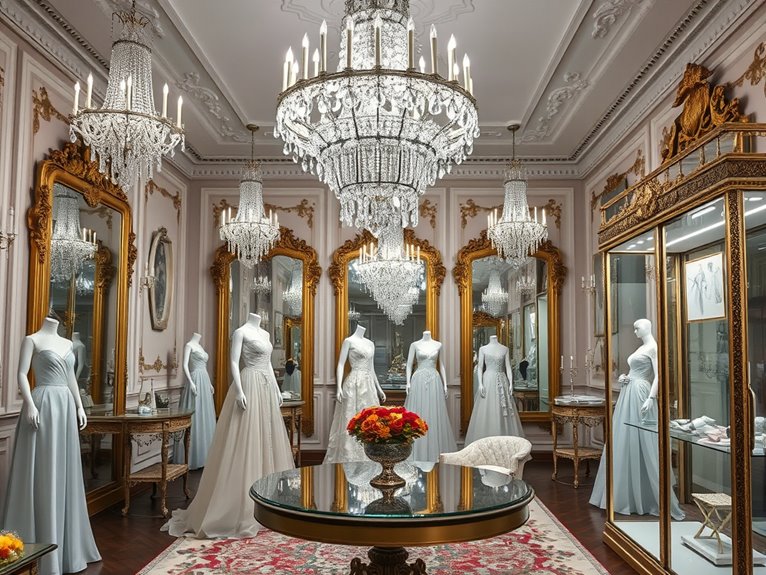
The House of Balenciaga stands as one of Paris's most prestigious fashion landmarks, representing over a century of haute couture excellence. Founded by Spanish designer Cristóbal Balenciaga in 1919 and established in Paris in 1937, the maison has maintained its position as a pioneer in fashion innovation and architectural design principles in clothing.
This historic fashion house, located in the heart of Paris's 8th arrondissement, houses both an active couture atelier and a remarkable archive collection that spans decades of fashion history. The archive preserves thousands of original Balenciaga pieces, sketches, and documentation that showcase the evolution of haute couture and the distinctive Balenciaga aesthetic that influenced fashion worldwide.
Quick Facts:
- Visiting Hours: Monday-Friday, 10:00-18:00 (Archive by appointment only)
- Location: 10 Avenue George V, 75008 Paris
- Price Range: Archive tours starting at €200 per person
- Photography: Limited to specific areas; no flash photography
- Language: Tours available in French, English, and Spanish
- Advance Booking: Minimum 3 months for archive visits
- Dress Code: Smart casual required
The Historic Atelier
The working atelier maintains many of the original features from Cristóbal Balenciaga's time, including the iconic mirrored salon where clients once attended private fittings. The space continues to produce haute couture collections, employing traditional techniques alongside modern innovations. Insider tip: Request to see the original fitting rooms, which still contain Balenciaga's personal measuring tools.
The Archive Collection
Housing over 6,000 original pieces, the archive serves as both a museum and research center for fashion historians and designers. Highlights include the revolutionary 1950s cocoon coats and the architectural evening gowns that defined the house's aesthetic. Unique feature: The archive contains Balenciaga's personal collection of fabric samples, including extinct textiles no longer in production.
Current Exhibition Space
The house maintains a rotating exhibition space showcasing specific periods or themes from Balenciaga's history. These curated displays often feature pieces never before shown to the public, alongside contemporary interpretations by current creative directors. Special access: Some exhibitions include demonstrations of couture techniques by current atelier artisans.
Pro Tips:
The ideal time to visit the archive is during Paris Fashion Week when the house occasionally opens additional spaces to the public. Schedule archive visits at least six months in advance for the best chance of securing a spot, and request a combined tour of both the archive and active atelier. Consider visiting during the winter months when smaller tour groups allow for more personalized attention and detailed explanations of the collections.
Practical Advice:
When planning a visit to Balenciaga's historic spaces, work with a luxury concierge service or contact the house directly through their VIP client services. Photography permissions must be arranged in advance, and visitors should be prepared to sign confidentiality agreements regarding certain archived materials and current collection pieces. Comfortable yet elegant footwear is essential, as tours can last several hours and involve standing in historic spaces where seating is limited.
The Atelier and Heritage Room at Boucheron Place Vendôme
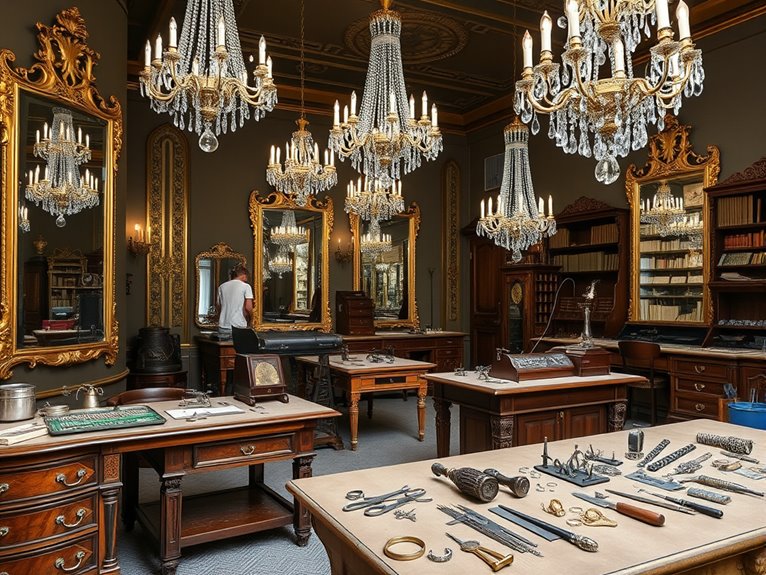
Nestled within the historic 26 Place Vendôme, Boucheron's atelier and heritage room represent the beating heart of one of Paris's most prestigious jewelry maisons. This exceptional space, where craftsmanship meets history, offers visitors a rare glimpse into the world of haute joaillerie, showcasing both the contemporary artistry and rich heritage of a house that has adorned royalty and celebrities since 1858.
The atelier, located on the upper floors of the mansion, continues the tradition of creating extraordinary pieces while the heritage room houses an impressive collection of historic jewelry, original designs, and artifacts that tell the story of Boucheron's evolution. Together, these spaces provide an intimate look at the meticulous work of master craftsmen and the preservation of centuries-old techniques that define French luxury.
Quick Facts:
- Visiting Hours: Monday-Friday, 10:00-18:00 (by appointment only)
- Price: Private tours start at €500
- Photography: Limited, subject to specific areas
- Group Size: Maximum 6 persons
- Language Options: French, English, Mandarin
- Advance Booking: Minimum 3 weeks required
- Dress Code: Smart casual
The Atelier Experience:
The working atelier showcases master craftsmen at their benches, demonstrating techniques passed down through generations. Visitors observe the creation of high jewelry pieces from initial sketches to final settings. Located on the fourth floor, the space maintains its original 19th-century layout, complete with large windows providing natural light necessary for detailed work. A unique feature rarely mentioned is the preserved workbench of Frédéric Boucheron himself, still occasionally used for special commissions.
The Heritage Room:
Located on the second floor, the heritage room houses over 150 years of Boucheron history. The collection includes original sketches, molds, and iconic pieces worn by historical figures. The room features a state-of-the-art vault system that protects priceless artifacts while allowing intimate viewing. An insider secret: request to see the "inspiration drawers" – carefully curated collections of natural elements that have inspired designs throughout the decades.
Pro Tips:
Morning visits (10:00-12:00) offer the best opportunity to see craftsmen at work, as this is when natural light is most favorable for detailed jewelry work. Request a visit during the preparation of a high jewelry collection (usually June-July) to witness the extraordinary energy of the atelier at its peak. Consider combining your visit with a viewing of current collections in the boutique below.
Practical Advice:
Due to security protocols and the exclusive nature of the experience, visitors must provide identification and booking confirmation in advance. All bags must be stored in secure lockers, and phones may be collected before entering certain areas. Wear comfortable shoes as the tour involves stairs, and bring reading glasses if needed for examining detailed pieces. The maison can arrange private transportation from your hotel to guarantee a seamless experience.
